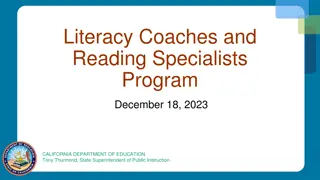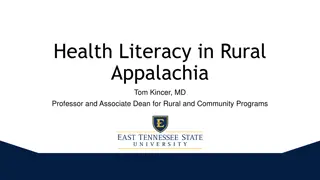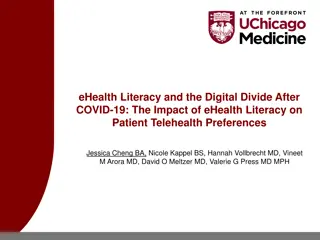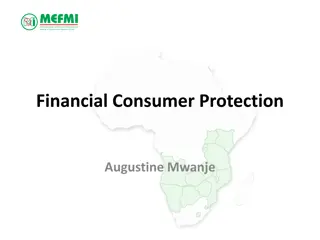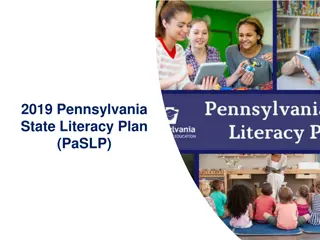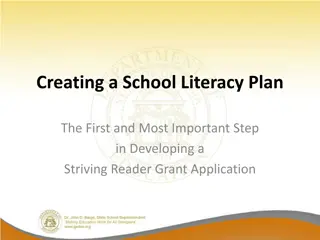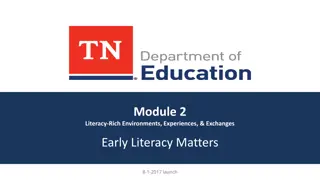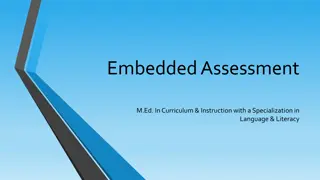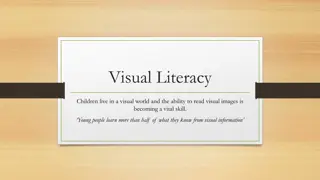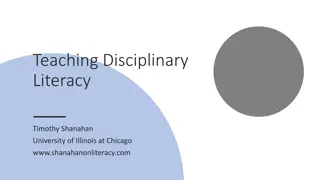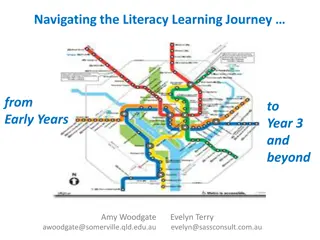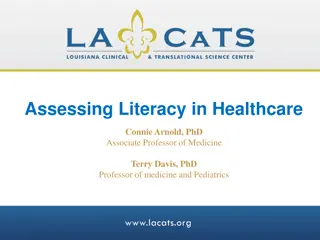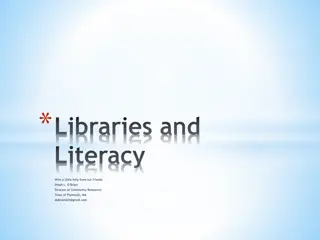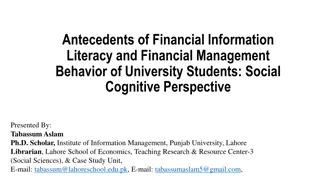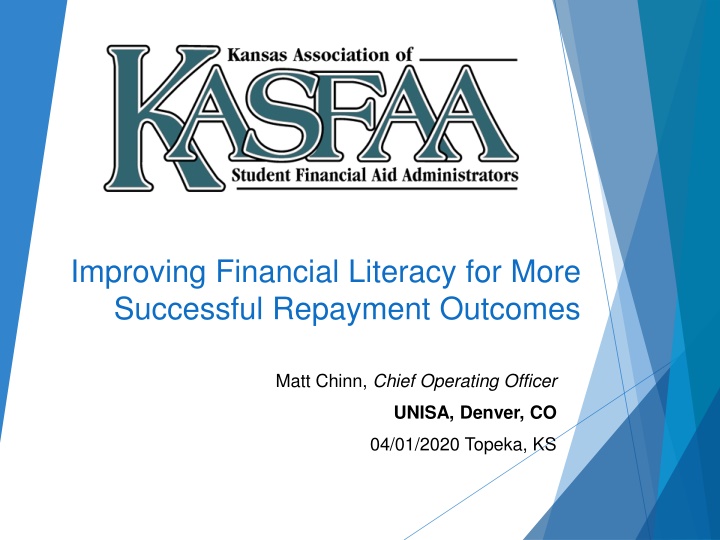
Financial Literacy Training for Successful Repayment Outcomes
Enhancing financial literacy is crucial for better repayment outcomes of student loans. This includes preparing students for managing debts, budgeting, and savings. The article explores strategies to improve financial literacy among students to ensure successful loan repayment.
Uploaded on | 0 Views
Download Presentation

Please find below an Image/Link to download the presentation.
The content on the website is provided AS IS for your information and personal use only. It may not be sold, licensed, or shared on other websites without obtaining consent from the author. If you encounter any issues during the download, it is possible that the publisher has removed the file from their server.
You are allowed to download the files provided on this website for personal or commercial use, subject to the condition that they are used lawfully. All files are the property of their respective owners.
The content on the website is provided AS IS for your information and personal use only. It may not be sold, licensed, or shared on other websites without obtaining consent from the author.
E N D
Presentation Transcript
Improving Financial Literacy for More Successful Repayment Outcomes Matt Chinn, Chief Operating Officer UNISA, Denver, CO 04/01/2020 Topeka, KS
THE OPPORTUNITY A tremendous opportunity and challenge to prepare our students for repayment of tuition and student loans Typically students are not prepared when entering Higher Ed Can the institution, student demographic and program make a difference? Perhaps financial literacy training in K-12 and at home can begin the discussion and introduce our future graduates and borrowers to financial literacy, debt management, budgeting, saving and planning for the future What can we do to assist and prepare students on the fly? 2
STUDENT LOANS & INSTITUTIONAL FINANCING Title IV (FASFA) Private & Personal Loans (Third Party Funding) Tuition Payment Plans (Extensions of Credit) Institutional Loans (Private Education Loans) 3
LOANS vs GRANT FEDERAL LOAN vs PRIVATE LOAN A Federal Pell Grant, unlike a loan, does not have to be repaid A loan is a thing that is borrowed, especially a sum of money that is expected to be paid back with interest. Federal student loans: are funded by the federal government Private student loans: are made by a lender such as a bank, credit union, state agency, or a school. https://studentaid.ed.gov/sa/types/loans/federal-vs-private 4
DEBT MANAGEMENT INFO CFPB Repay Student Debt (http://www.consumerfinance.gov/paying-for-college/repay-student- debt/#Question-1) NSLDS Know What You Owe (http://www.colorado.edu/financialaid/video/know-what-you-owe- navigating-nslds) Custom handouts and cheat sheets, presentations, one-on-one examples of savings, budgeting, and planning 5
ENTRANCE AND EXIT Electronic vs in-person; Face-to-face is key is feasible Data shows exit counseling alone can increase collections and reduce defaults by 20% Rolling exits with PowerPoint Presentations (and pizza!) Introduce key school personnel and servicer contact info Loan specific info to drive home real world numbers and budgets 6
FINANCIAL LITERACY 101 9 Financial Literacy Tips for College Freshman 1. Talk with your parents 2. Budget, budget, budget 3. Apps are your best friends 4. Start building your credit 5. Buy used books 6. Beware of ID theft 7. Remember your student loans 8. Take advantage of student discounts 9. Save smartly https://www.policygenius.com/blog/financial-literacy-tips-college- freshmen/ 7
BUDGETING 101 Necessary Expenses (Rent/mortgage, utilities, maintenance, food, clothing, insurance, taxes & medical expenses) Essential Expenses (Transportation, car insurance, vehicle tax & fuel) Optional Expenses (Books, cable, internet, movies, entertainment & meals) Save money for the future and set money aside for emergencies Have the ability to adapt to life s changes and surprises 8 Spend less than you earn, borrower what you can afford!
PEER MENTORS Schools are encouraging work study students to mentor peers Peers go to mandatory coaching sessions and are eligible to be paid Lunch and learn Mock appointments Weekly training focus on wellness components, communication/helping skills, and finances 9
DEBT REDUCERS & REPAYMENT SCHEDULES Only borrow what you need and pay interest as it accrues (during school and deferment periods) Typically standard repayment is best Extended, Graduated, IBR/ICR, and PAYE repayment can assist with lower monthly payments but can increase interest paid, increase the length of repayment and increase the likelihood of not paying off the loan A discharged loan amount is generally treated as income 10
OTHER/MISC Mailed letters with loan amounts/what is owed Email and phone contact Managing cohorts proactively Texting Do any schools text? Regulatory Issues with texting 11
BORROWER BEST PRACTICES Make your first payment on time Stay in touch with your servicers and update address and contact changes NSLDS Know What You Owe Consolidate if it makes repayment more manageable Take advantage of automatic payments, incentives, discounts, settlements, and other advantages 12
BORROWER INCENTIVES Reduction in interest rate for automatic payments for federal direct student loans Some schools offer incentives for institutional loans such as reductions in principal balance for automatic payments and/or cancellation of a portion of the loan for graduating Take advantage of any incentive and conveniences your schools or servicers provide 13
BEST PRACTICES: INSTITUTIONAL FINANCING Student demographics and program can contribute to a combination of both a student and/or parent/family making payments FERPA, PCI-DSS, and Regulation Z s payment crediting compliance In-school payments creates the need to save, plan and budget and promotes repayment experience Multiple payment processing options for borrower convenience Opportunity to pay in full interest free 14
BEST PRACTICES: REPAYMENT REMINDERS Courtesy reminders via in-person, phone, email, mail, fax, and text USPS First Class ACS; presentment in-person (in class) and/or via email 24/7 account review and management online and via student portal Phone call reminder in addition to paper statement; follow-up support and contact outlets Text and/or email reminder before or on due date (Required disclosure and opt-out) 15
BEST PRACTICES: REPAYMENT REMINDERS Web based and administrator portals; electronic account review and account updates Entrance/exit counseling and references; continually harvest good contact information Expectations, obligations and consequences; credit checks, national credit bureau reporting and third party collection agency interface Automated and real time reporting and timely account review; timely and consistent past due courtesy contact and reminders 16
ACCOUNT AGING REPORT CURRENT, 31-60 DAYS, 61-90 DAYS, ETC. 19
BEST PRACTICES: DUE DILIGENCE Timely follow-up is key; timing and consistency in communication and messaging is vital Documentation of all due diligence and collection efforts promote compliance Past due courtesy contact provides an opportunity for feedback and can be used as a positive public relations; opportunity to nurture a long lasting relationship post separation Skip tracing and letter series (Final demand, right to cure, etc.) 20
BEST PRACTICES: INSTITUTIONAL LOAN INCENTIVES Reduction in interest rate for automatic payments or co-signer Reductions in principal balance for automatic payments and/or cancellation of a portion of the loan for successful program completion Current at time of graduation for out of school reduction of balance owed and opportunity to get current at time of graduation if past due Debt reducers and promotion of paying in full before Title IV loan repayment; grace period and tax incentives 21
BEST PRACTICES: INSTITUTIONAL LOAN MODEL Importance of first payment; educate students about the importance of paying on time and promote incentives and grace periods Multiple support outlets and multiple payment processing options with no fees (ACH, credit/debit, check, money order, cash and/or automatic payments) In-school payments promote default management while out of school Federal loan model may hinder recovery; affordability contributing to retention 22
CHANGING LIVES Lifelong fiscal and repayment experience Budgeting Saving Planning Making a difference in a student s life 23
THANK YOU & QUESTIONS Matt Chinn, UNISA, INC. (800) 875-8910 matt.chinn@unisainc.com 24

